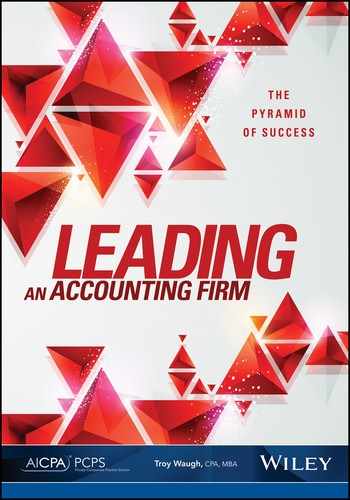Section 4
Leading Systems
The systems necessary to operate as a sole CPA are radically different than those needed to manage a multimillion dollar, multioffice, multipartner business. The same is true for the incremental steps along the way. One of the reasons that I wanted to interview so many founders of firms was to get them to describe for me the incremental systems that they used and the continuous changes that were employed along their growth path. Many of these leaders led their firms from start-up to being a part of the elite top 100 firms in the United States.
Section four, comprising chapters 14–15, is all about management systems and processes and their continuing changes as your firm evolves into your future. One of the biggest mistakes we witness in stagnated CPA firms is that they are still using the same processes that they used 5, 10, or 20 years ago. For example, it is common for us to encounter partners in firms that handle 300–700 clients: 280–650 small individual tax clients and 20–50 significant individual or corporate clients. In many of these firms, the managing partner carries a large book of business, and he or she is constantly challenging the other partners to do more.
Managing Processes for Your Future Firm |
Building the Future Firm Continuously |
Section Four: Leading Systems |
|
A visionary leader’s role cannot be carried out without someone, or a group, ensuring that the processes being used in the business fit the leader, team, and leader’s strategy. Too often, the antiquated processes hold the team hostage to doing things the old way and to not move forward.
Much has been written and said about managing an accounting firm. Management of an accounting practice conferences have been occurring on international, national, and state levels for more than 30 years. Jay Nisberg spoke at one of the very first in the United States and has been a leading authority on managing a firm. His book, along with coauthors Gary Shamis and Marsha Leest, How to Manage Your Accounting Practice: Taking Your Firm from Chaos to Consensus, is an excellent resource on this vital subject. David Maister’s Managing the Professional Service Firm has been the management bible on this topic for over 15 years. This section is not designed to cover all the topics that are already covered very well in these other forums, but I will put management in context with leadership to illustrate the high value that great management offers the accounting firm.
Napoleon quipped, “An army marches on its stomach.” No matter how great a leader may be, without processes, supplies, and management, the best defined vision will fail. Leaders must rely on good managers to understand and carry out the vision of the firm within the values adopted by the organization. Managers and leaders need efficient, repeatable processes to ensure success. If you don’t have a system to provide structure, each decision becomes a “new” issue. By having a systematic approach to how you do things, you can more quickly learn from experience and implement your initiatives more successfully and easily. Most importantly, the processes must support the leader, team, and strategy. The people and strategy must not be slaves to the processes.
During the first 13 chapters of this book, we covered the leadership aspects of doing the right things. Management systems will help the leader actually accomplish his or her vision by doing things right. When leaders and managers work together, potential business harmony and synergy can be realized. Without such harmony, owners will constantly grapple with organizational friction that will impede growth.
The best leaders recognize that managing is a different role than serving clients with accounting, tax, or consulting services. Management is a specific skill that requires training, experience, and dedication. One of the most difficult issues that confronts growing firms is expecting excellent management from part timers. After my son, at age 10, suffered a knee injury playing football, he told me that when he grew up, he wanted to be a quarterback and part-time bone doctor. I still chuckle at that childish remark, and yet, that is the challenge for many CPAs: they want to spend most of their time serving clients and also be part-time managers, which is very difficult.
Jim DeMartini, managing partner of the top-100 firm Seiler LLP in Redwood City, CA, explains, “One of the best decisions we made was off loading most of our management responsibilities to a chief operating officer who is a professional manager.” Many small firms take a step toward hiring a firm administrator, which will ease the growth pangs for a while.
As you can determine, I believe that good management is a subset of good leadership. Without management, a leader will fail every time, but management may not be the leader’s strength. In chapters 14–15, we will discuss the role of the manager; some of the metrics of running an accounting firm; and most importantly, a challenge to continuous improvement in all the processes and procedures. The most important point I want to make is that management, processes, and procedures are the tools of great leaders, not the other way around. I believe that many accounting firms are overmanaged and underled, which can be disastrous for a firm. You could fall into the trap of doing the wrong things in the right way, leading you to be very efficient in a poorly conceived direction.
